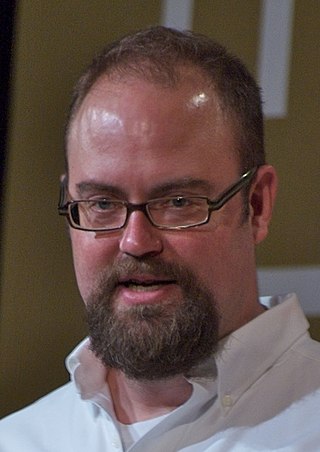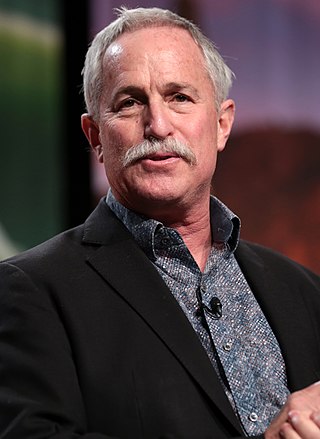
Natural Capitalism: Creating the Next Industrial Revolution is a 1999 book on environmental economics co-authored by Paul Hawken, Amory Lovins and Hunter Lovins. It has been translated into a dozen languages and was the subject of a Harvard Business Review summary.
The Viridian Design Movement was an aesthetic movement focused on concepts from bright green environmentalism. The name was chosen to refer to a shade of green that does not quite look natural, indicating that the movement was about innovative design and technology, in contrast with the "leaf green" of traditional environmentalism. The movement tied together environmental design, techno-progressivism, and global citizenship. It was founded in 1998 by Bruce Sterling, a postcyberpunk science fiction author. Sterling always remained the central figure in the movement, with Alex Steffen perhaps the next best-known. Steffen, Jamais Cascio, and Jon Lebkowsky, along with some other frequent contributors to Sterling's Viridian notes, formed the Worldchanging blog. Sterling wrote the introduction to Worldchanging's book, which is considered the definitive volume on bright green thinking. Sterling formally closed the Viridian movement in 2008, saying there was no need to continue its work now that bright green environmentalism had emerged.
David Holmgren is an Australian environmental designer, ecological educator and writer. He is best known as one of the co-originators of the permaculture concept with Bill Mollison.
Techno-progressivism or tech-progressivism is a stance of active support for the convergence of technological change and social change. Techno-progressives argue that technological developments can be profoundly empowering and emancipatory when they are regulated by legitimate democratic and accountable authorities to ensure that their costs, risks and benefits are all fairly shared by the actual stakeholders to those developments. One of the first mentions of techno-progressivism appeared within extropian jargon in 1999 as the removal of "all political, cultural, biological, and psychological limits to self-actualization and self-realization".

Alex Steffen is an American futurist and advocate of 'bright green environmentalism' who writes and speaks about sustainability and the future of the planet. He emphasizes the importance of imagining persuasive, positive possible futures: "It's literally true that we can't build what we can't imagine,... The fact that we haven't compellingly imagined a thriving, dynamic, sustainable world is a major reason we don't already live in one."

William Andrews McDonough is an American architect and academic. McDonough is the founding principal of William McDonough + Partners and was the dean of the School of Architecture at the University of Virginia. He works in green and sustainable architecture, often incorporating his theory of cradle-to-cradle design.
Andrew J. Hoffman is a scholar of environmental issues and sustainable enterprise. He is the Holcim (US) Professor of Sustainable Enterprise at the University of Michigan's Ross School of Business and School for Environment and Sustainability (SEAS). His research uses a sociological perspective to understand the cultural and institutional aspects of environmental issues for organizations. In particular, he focuses on the processes by which environmental issues both emerge and evolve as social, political and managerial issues. He has written extensively about: the evolving nature of field level pressures related to environmental issues; the corporate responses that have emerged as a result of those pressures, particularly around the issue of climate change; the interconnected networks among non-governmental organizations and corporations and how those networks influence change processes within cultural and institutional systems; the social and psychological barriers to these change processes; and the underlying cultural values that are engaged when these barriers are overcome. His Ph.D. was conferred by the Massachusetts Institute of Technology in 1995. He is an expert in environmental pollution and has published eighteen books and over one-hundred articles and book chapters.
Worldchanging was a nonprofit online publisher that operated from 2003 to 2010. Its strapline was A bright green future. It published newsletters and books about sustainability, bright green environmentalism, futurism and social innovation.
Social design is the application of design methodologies in order to tackle complex human issues, placing the social issues as the priority. Historically social design has been mindful of the designer's role and responsibility in society, and of the use of design processes to bring about social change. Social design as a discipline has been practiced primarily in two different models, as either the application of the human-centered design methodology in the social sector or governmental sector, or sometimes is synonymously practiced by designers who venture into social entrepreneurship.

Stefan Sagmeister is an Austrian graphic designer, storyteller, and typographer based in New York City. In 1993, Sagmeister founded his company, Sagmeister Inc., to create designs for the music industry. He has designed album covers for Lou Reed, OK Go, The Rolling Stones, David Byrne, Jay Z, Aerosmith, Talking Heads, Brian Eno and Pat Metheny. From 2011 until 2019 he partnered with Jessica Walsh under the name Sagmeister & Walsh Inc.
Bright green environmentalism is an ideology based on the belief that the convergence of technological change and social innovation provides the most successful path to sustainable development.

Joel Makower is an American entrepreneur, writer and strategist on sustainable business, clean technology, and green marketing. His work has focused on three principal topics: how companies of all sizes and sectors are integrating environmental thinking into their operations in a way that produces business value; the creation of new companies and markets for clean energy, clean water, and advanced materials; and the strategies and tactics that companies use in order to communicate and market their environmental efforts and leadership, especially to consumers.
Product-service systems (PSS) are business models that provide for cohesive delivery of products and services. PSS models are emerging as a means to enable collaborative consumption of both products and services, with the aim of pro-environmental outcomes.

John Elkington is an author, advisor and serial entrepreneur. He is an authority on corporate responsibility and sustainable development. He has written and co-authored 20 books, including the Green Consumer Guide, Cannibals with Forks: The Triple Bottom Line of 21st Century Business, The Power of Unreasonable People: How Social Entrepreneurs Create Markets That Change the World, and The Breakthrough Challenge: 10 Ways to Connect Tomorrow's Profits with Tomorrow's Bottom Line.

Jacquelyn A. Ottman is a New York City-based consultant specializing in sustainability strategy, green marketing, and eco-innovation. She is the author or co-author of four books on green marketing, including The New Rules of Green Marketing: Strategies, Tools, and Inspiration for Sustainable Branding. She has advised Fortune 500 companies, including GE, Johnson & Johnson, and Procter & Gamble, along with the United States Environmental Protection Agency Energy Star Label She blogs at GreenMarketing.com and at WeHateToWaste.com.
Andrew L. Shapiro has been an influential voice on environmental innovation in business for a decade. He has built a career, and a pioneering advisory group, GreenOrder, around the idea that sustainability can be a critical driver of profitable growth.

William John Mitchell was an Australian-born author, educator, architect and urban designer, best known for leading the integration of architectural and related design arts practice with computing and other technologies.
Environmentally sustainable design is the philosophy of designing physical objects, the built environment, and services to comply with the principles of ecological sustainability and also aimed at improving the health and comfort of occupants in a building. Sustainable design seeks to reduce negative impacts on the environment, the health and well-being of building occupants, thereby improving building performance. The basic objectives of sustainability are to reduce the consumption of non-renewable resources, minimize waste, and create healthy, productive environments.
The Holcim Foundation for Sustainable Construction is a non-profit organization. Its goal is to raise awareness of the role that architecture, engineering, urban planning and construction have in achieving a sustainable built future. The organization encourages and rewards sustainable responses to the technological, environmental, socioeconomic, and cultural issues affecting building and construction. The Holcim Foundation for Sustainable Construction promotes thought leadership on a greener, smarter, circular, and more inclusive built environment.
New Resource Bank is a San Francisco, California-based bank which is a part of Amalgamated Bank.








